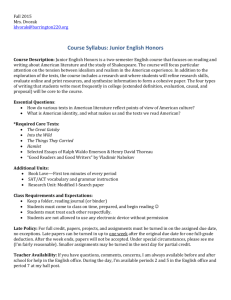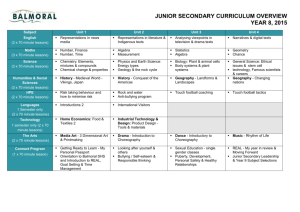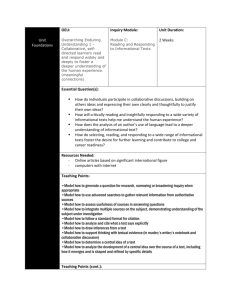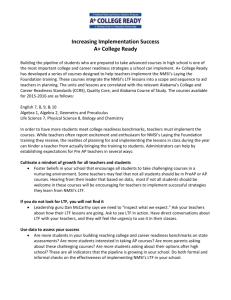Seventh Grade Honors English
advertisement
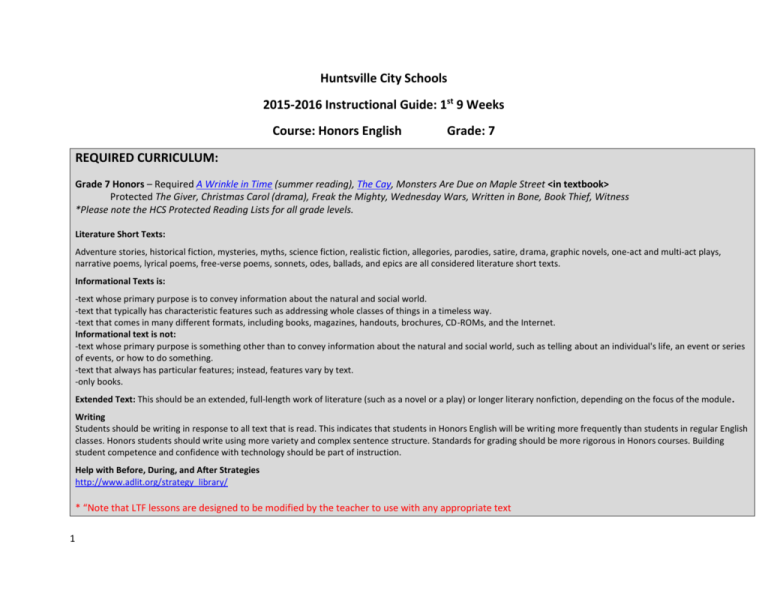
Huntsville City Schools 2015-2016 Instructional Guide: 1st 9 Weeks Course: Honors English Grade: 7 REQUIRED CURRICULUM: Grade 7 Honors – Required A Wrinkle in Time (summer reading), The Cay, Monsters Are Due on Maple Street <in textbook> Protected The Giver, Christmas Carol (drama), Freak the Mighty, Wednesday Wars, Written in Bone, Book Thief, Witness *Please note the HCS Protected Reading Lists for all grade levels. Literature Short Texts: Adventure stories, historical fiction, mysteries, myths, science fiction, realistic fiction, allegories, parodies, satire, drama, graphic novels, one-act and multi-act plays, narrative poems, lyrical poems, free-verse poems, sonnets, odes, ballads, and epics are all considered literature short texts. Informational Texts is: -text whose primary purpose is to convey information about the natural and social world. -text that typically has characteristic features such as addressing whole classes of things in a timeless way. -text that comes in many different formats, including books, magazines, handouts, brochures, CD-ROMs, and the Internet. Informational text is not: -text whose primary purpose is something other than to convey information about the natural and social world, such as telling about an individual's life, an event or series of events, or how to do something. -text that always has particular features; instead, features vary by text. -only books. Extended Text: This should be an extended, full-length work of literature (such as a novel or a play) or longer literary nonfiction, depending on the focus of the module. Writing Students should be writing in response to all text that is read. This indicates that students in Honors English will be writing more frequently than students in regular English classes. Honors students should write using more variety and complex sentence structure. Standards for grading should be more rigorous in Honors courses. Building student competence and confidence with technology should be part of instruction. Help with Before, During, and After Strategies http://www.adlit.org/strategy_library/ * “Note that LTF lessons are designed to be modified by the teacher to use with any appropriate text 1 Standard “I Can” Statements Suggested Resources *suggested resources are not required Pacing Recomme ndation / Date(s) Taught 1st 9 weeks Minimum Requirements: Honors English 2 literature short texts 1 informational texts 1 extended informational text Text levels – 7 and above 3 LTF lessons Reading Literature Cite several pieces of textual evidence to support analysis of what the text says explicitly as well as inferences drawn from the text. [RL.7.1] Analyze how an author develops and contrasts the points of view of different characters or narrators in a text. [RL.7.6] *I CAN statements will be created by individual teachers A+ College Ready Scope and Sequence Poetry: “Saturday at the Canal” by Gary Soto Short Story: “By the Waters of Babylon” by Stephen Vincent Benet Artwork: Jamestown Lifescape by Keith Rocco Videos: Lost Colony of Roanoke , Pearson Realize Short Stories and Poetry “Seventh Grade” by Gary Soto “Baseball” by Gary Sot “Annabel Lee” “Mother to Son” and “The Courage that my Mother Had” can be compared/contrasted “The Cremation of Sam McGee” Literature Circles: http://www.readwritethink.org/classroomresources/lesson-plans/literature-circles-gettingstarted-19.html?tab=4#tabs LTF: Foundation Lesson: Point of View 2 *to be determined by individual teachers Point of View: “The First Day” Synthesis: Animal Testing (with test and MC Key) Interdisciplinary Research Project-Connecting Literature and History Reading Informational Texts Cite several pieces of textual evidence to support analysis of what the text says explicitly as well as inferences drawn from the text. [RI.7.1] Determine two or more central ideas in a text and analyze their development over the course of the text; provide an objective summary of the text. [RI.7.2] A+ College Ready Scope and Sequence Extended Work: Written in Bone: Buried Lives of Jamestown and Colonial Maryland by Sally Walker Nonfiction article: “The Lost Colony of Roanoke Island” Newsela.com Teentribune.com Listencurrent.com Writing Standards Write informative or explanatory texts to examine a topic and convey ideas, concepts, and information through the selection, organization, and analysis of relevant content. [W.7.2] a. Introduce a topic clearly, previewing what is to follow; organize ideas, concepts, and information, using strategies such as definition, classification, comparison or contrast, and cause and effect; include formatting (e.g., headings), graphics (e.g., charts, tables), and multimedia when useful to aiding comprehension. [W.7.2a] b. Develop the topic with relevant facts, definitions, concrete details, quotations, or other information and examples. [W.7.2b] c. Use appropriate transitions to create cohesion and clarify the relationships among ideas and concepts. [W.7.2c] d. Use precise language and domain-specific vocabulary to inform about or explain the topic. [W.7.2d] e. Establish and maintain a formal style. [W.7.2e] f. Provide a concluding statement or section that follows from and supports the information or explanation presented. [W.7.2f] Write routinely over extended time frames, including time for research, reflection, and revision, and shorter time frames such as a single sitting or a day or two for a range of discipline-specific tasks, purposes, and audiences. [W.7.10] 3 Prentice Hall Writing Coach and/or Write to Learn-- depending on school availability LTF: Foundation Lesson: Origami House Project Speaking and Listening Engage effectively in a range of collaborative discussions (one-on-one, in groups, and teacher-led) with diverse partners on grade 7 topics, texts, and issues, building on others’ ideas and expressing their own clearly. [SL. 7.1] a. Come to discussions prepared, having read or researched material under study; explicitly draw on that preparation by referring to evidence on the topic, text, or issue to probe and reflect on ideas under discussion. [SL. 7.1a] b. Follow rules for collegial discussions, track progress toward specific goals and deadlines, and define individual roles as needed. [SL. 7.1b] c. Pose questions that elicit elaboration and respond to others’ questions and comments with relevant observations and ideas that bring the discussion back on topic as needed. [SL.7.1c] d. Acknowledge new information expressed by others and, when warranted, modify their own views. [SL.7.1d] Analyze the main ideas and supporting details presented in diverse media and formats (e.g., visually, quantitatively, or orally) and explain how the ideas clarify a topic, text, or issue under study. [SL.7.2] Language Standards Demonstrate command of the conventions of Standard English grammar and usage when writing or speaking. [L.7.1] a. Demonstrate knowledge of subject-verb agreement when interrupted by a prepositional phrase, with inverted word order, with indefinite pronouns as subjects, compound subjects joined by correlative and coordinating conjunctions, and collective nouns when verb form depends on the rest of the sentence. Demonstrate command of the conventions of Standard English capitalization, punctuation, and spelling when writing. [L.7.2] a. Use a comma to separate coordinate adjectives (e.g., It was a fascinating, enjoyable movie but not He wore an old[,] green shirt). [L.7.2a] b. Spell correctly. [L.7.2b] No Red Ink Edmodo app Prentice Hall Writing Coach www.chompchomp.com (Grammar Bytes) Reminder: Teachers should continue to reinforce and assess these standards in the classroom throughout the year. 4 Every day (or several days a week) as bellringer Huntsville City Schools 2015-2016 Instructional Guide: 2nd 9 Weeks Course: Honors English Grade: 7 Standard 2nd 9 weeks Minimum Requirements: Honors English 2 literature short texts 3 informational texts 1 extended text – literature Text levels – 7 and above 3 LTF lessons 5 “I Can” Statements Suggested Resources *suggested resources are not required Pacing Recommen dation / Date(s) Taught Reading Literature Analyze how particular elements of a story or drama interact (e.g., how setting shapes the characters or plot). [RL.7.3] Compare and contrast a written story, drama, or poem to its audio, filmed, staged, or multimedia version, analyzing the effects of techniques unique to each medium (e.g., lighting, sound, color, or camera focus and angles in a film). [RL.7.7] A+ College Ready Scope and Sequence Extended Text: A Wrinkle in Time by Madeleine L’Engle Drama: The Monsters are Due on Maple Street Fable: “The Fox and the Crow” Excerpts from Witness by Karen Hesse Pearson Realize Short Stories “Amigo Brothers” “Rikki Tikki Tavi” “The Treasure of Lemon Brown” “Two Kinds” “Third Wish” “After Twenty Years” “All Summer in a Day” Extended Works: The Giver Freak the Mighty Holes Wringer The Hunger Games Alabama Moon Child of the Owl Flowers for Algernon Hatchet Island of the Blue Dolphin Witness Out of the Dust A Christmas Carol LTF: Analyzing Characterization through Conflict using Hatchet Peeling Back The Layers: Mossflower Moving through levels of Thinking Conflict and Theme Maybe you CAN Judge a Book by its Cover (TONE AND MOOD) 6 Reading Informational Texts Analyze the interactions between individuals, events, and ideas in a text (e.g., how ideas influence individuals or events, or how individuals influence ideas or events). [RI.7.3] Compare and contrast a text to an audio, video, or multimedia version of the text, analyzing each medium’s portrayal of the subject (e.g., how the delivery of a speech affects the impact of the words). RI 7.7 A+ College Ready Scope and Sequence Nonfiction Documents: “An Open Heart,” “A Wrinkle in Time’ and Its Sci-Fi Heroine” Drama: Pearson Realize: Reality Central Newsela.com Teentribune.com Listencurrent.com Writing Standards Draw evidence from literary or informational texts to support analysis, reflection, and research. [W.7.9] a. Apply Grade 7 Reading standards to literature (e.g., ―Compare and contrast a fictional portrayal of a time, place, or character and a historical account of the same period as a means of understanding how authors of fiction use or alter history‖). [W.7.9a] b. Apply grade 7 Reading standards to literary nonfiction (e.g. “Trace and evaluate the argument and specific claims in a text, assessing whether the reasoning is sound and the evidence is relevant and sufficient to support the claims”). [W.7.10] With some guidance and support from peers and adults, develop and strengthen writing as needed by planning, revising, editing, rewriting, or trying a new approach, focusing on how well purpose and audience have been addressed. (Editing for conventions should demonstrate command of the first three standards in the Language strand in Grades K-7.) [W.7.5] 7 Prentice Hall Writing Coach and/or Write to Learn (depending on school availability) Speaking and Listening Include multimedia components and visual displays in presentations to clarify claims and findings and emphasize salient points. [SL.7.5] Adapt speech to a variety of contexts and tasks, demonstrating command of formal English when indicated or appropriate. (See grade 7 Language standards 1 and 3 on page 53 for specific expectations.) Language Standards Determine or clarify the meaning of unknown and multiplemeaning words and phrases based on Grade 7 reading and content, choosing flexibly from a range of strategies. [L.7.4] Determine or clarify the meaning of unknown and multiplemeaning words and phrases based on Grade 7 reading and content, choosing flexibly from a range of strategies. [L.7.4] a. Use context (e.g., the overall meaning of a sentence or paragraph; a word’s position or function in a sentence) as a clue to the meaning of a word or phrase. [L.7.4a] b. Use common, grade-appropriate Greek or Latin affixes and roots as clues to the meaning of a word (e.g., belligerent, bellicose, rebel). [L.7.4b] c. Consult general and specialized reference materials (e.g., dictionaries, glossaries, thesauruses), both print and digital, to find the pronunciation of a word or determine or clarify its precise meaning or its part of speech. [L.7.4c] d. Verify the preliminary determination of the meaning of a word or phrase (e.g., by checking the inferred meaning in context or in a dictionary). [L.7.4d] No Red Ink Edmodo app Prentice Hall Writing Coach www.chompchomp.com (Grammar Bytes) Reminder: Teachers should continue to reinforce and assess these standards in the classroom throughout the year. 8 Huntsville City Schools 2015-2016 Instructional Guide: 3rd 9 Weeks Course: Honors English Standard “I Can” Statements * Grade: 7 Suggested Resources *suggested resources are not required 3rd 9 weeks Minimum Requirements: Honors English 2 literature short texts 3 informational texts 1 extended text - literature Text levels – 7 and above 3 LTF lessons Reading Literature Compare and contrast a fictional portrayal of a time, place, or character and a historical account of the same period as a means of understanding how authors of fiction use or alter history. RL7.9 A+ College Ready Scope and Sequence Extended Text: The Book Thief by Markus Zusak Poetry:“Nothing Gold Can Stay,” “Dream Deferred,” “‘Hope’ Is the Thing With Feathers” Artwork: “Grim Death,” “The Angel of Death,” “Abstract Death Person Realize Poetry “The Highwayman” “Dragonwings” Extended Text: 9 Pacing Recommendati on / Date(s) Taught Anne Frank: The Diary of a Young Girl A Day of Tears Reading Informational Texts Analyze the structure an author uses to organize a text, including how the major sections contribute to the whole and to the development of the ideas. [RI.7.5] Determine an author’s point of view or purpose in a text and analyze how the author distinguishes his or her position from that of others. [RI.7.6] Trace and evaluate the argument and specific claims in a text, assessing whether the reasoning is sound and the evidence is relevant and sufficient to support the claims. RI 7.8 Analyze how two or more authors writing about the same topic shape their presentations of key information by emphasizing different evidence or advancing different interpretations of facts. RI 7.9 A+ College Ready Scope and Sequence: Speech on the Americans with Disabilities by Christopher Reeve New York Times article “Auschwitz Shifts from Memorializing to Teaching ,” “Banning Books from the Classroom: How to Handle Cries for Censorship,” “In Defense of Book Banning, “It’s Not Censorship, It’s Parenting!” Videos: “Nazi Book Burning,” “Books Burn as Goebbels Speaks Germany”, May 10, 1933” ProCon.org Bush’s 911 Speech http://www.presidentialrhetoric.com/speeches/09.2 0.01.html “I Have a Dream” speech by Dr. Martin Luther King http://www.americanrhetoric.com/speeches/mlkiha veadream.htm LTF: Christopher Reeve: The American Disabilities Act RI10-14 Determining: Fact, Opinion, Bias Finding Appeals in Contemporary Speeches http://training.nms.org/Portals/ltftraining/docs/englis h/Training%20Materials/Module%209/Finding_Appeal s_TO.pdf 10 Writing Standards Write arguments to support claims with clear reasons and relevant evidence. [W.7.1] a. Introduce claim(s), acknowledge alternate or opposing claims, and organize the reasons and evidence logically. [W.7.1a] b. Support claim(s) with logical reasoning and relevant evidence, using accurate, credible sources and demonstrating an understanding of the topic or text. [W.7.1b] c. Use words, phrases, and clauses to create cohesion and clarify the relationships among claim(s), reasons, and evidence. [W.7.1c] d. Establish and maintain a formal style. [W.7.1d] e. Provide a concluding statement or section that follows from and supports the argument presented. [W.7.1e] Produce clear and coherent writing in which the development, organization, and style are appropriate to task, purpose, and audience. (Grade-specific expectations for writing types are defined in standards 20-22 above.) [W.7.4] Speaking and Listening Delineate a speaker’s argument and specific claims, evaluating the soundness of the reasoning and the relevance and sufficiency of the evidence. [SL.7.3] Present claims and findings, emphasizing salient points in a focused, coherent manner with pertinent descriptions, facts, details, and examples; use appropriate eye contact, adequate volume, and clear pronunciation. [SL.7.4] 11 Prentice Hall Writing Coach and/or Write to Learn depending on school availability ProCon.org Language Standards Demonstrate command of the conventions of Standard English grammar and usage when writing or speaking. [L.7.1] b. Explain the function of phrases and clauses in general and their function in specific sentences. [L.7.1a] c. Choose among simple, compound, complex, and compound-complex sentences to signal differing relationships among ideas. [L.7.1b] No Red Ink Edmodo app Prentice Hall Writing Coach www.chompchomp.com (Grammar Bytes) Use knowledge of language and its conventions when writing, speaking, reading, or listening. [L.7.3] a. Choose language that expresses ideas precisely and concisely, recognizing and eliminating wordiness and redundancy.* [L.7.3a] Reminder: Teachers should continue to reinforce and assess these standards in the classroom throughout the year. 12 Huntsville City Schools 2015-1016 Instructional Guide: 4th 9 Weeks Course: Honors English Standard 4th 9 weeks Minimum Requirements: Honors English 3 literature short texts 2 informational texts 1 extended text – literature Text levels – 7 and above 3 LTF lessons 13 Grade: 7 “I Can” Statements * Suggested Resources *suggested resources are not required Pacing Recommendation / Date(s) Taught Reading Literature Determine a theme or central idea of a text and analyze its development over the course of the text; provide an objective summary of the text. [RL.7.2] Determine the meaning of words and phrases as they are used in a text, including figurative and connotative meanings; analyze the impact of rhymes and other repetitions of sounds (e.g., alliteration) on a specific verse or stanza of a poem or section of a story or drama. [RL.7.4] Analyze how a drama or poem’s form or structure (e.g., soliloquy, sonnet) contributes to its meaning. [RL.7.5] By the end of the year, read and comprehend literature, including stories, dramas, and poems, in the Grades 6-8 text complexity band proficiently, with scaffolding as needed at the high end of the range. [RL.7.10] A+ College Ready Scope and Sequence Extended Text: The Cay by Theodore Taylor Excerpts from Twelfth Night by Shakespeare Poetry: “Blow, Blow Thou Winter Wind” Video: Clips from various productions of Twelfth Night, “Like a Girl” and “Be a Dad” PSAs Pearson Realize: Poetry and Drama units Extended Works: The Hobbit Monster LTF: Peeling Back Layers“Sister” Synthesizing Poetry Strategies for Interpreting Poetry How Literary Elements Create Meaning in “Riding is an Exercise of the Mind” Understanding Shakespeare: “Blow, Blow Thou Winter Wind” 14 Reading Informational Texts Determine the meaning of words and phrases as they are used in a text, including figurative, connotative, and technical meanings; analyze the impact of a specific word choice on meaning and tone. [RI.7.4] By the end of the year, read and comprehend literary nonfiction in the Grades 6-8 text complexity band proficiently, with scaffolding as needed at the high end of the range. [RI.7.10] Writing Standards Write narratives to develop real or imagined experiences or events using effective technique, relevant descriptive details, and well-structured event sequences. [W.7.3] a. Engage and orient the reader by establishing a context and point of view and introducing a narrator, characters, or both; organize an event sequence that unfolds naturally and logically. [W.7.3a] b. Use narrative techniques, such as dialogue, pacing, and description, to develop experiences, events, and/or characters. [W.7.3b] c. Use a variety of transition words, phrases, and clauses to convey sequence and signal shifts from one time frame or setting to another. [W.7.3c] d. Use precise words and phrases, relevant descriptive details, and sensory language to capture the action and convey experiences and events. [W.7.3d] e. Provide a conclusion that follows from and reflects on the narrated experiences or events. [W.7.3e] Use technology, including the Internet, to produce and publish writing and link to and cite sources as well as to interact and collaborate with others, including linking to and citing sources. [W.7.6] Conduct short research projects to answer a question, drawing on several sources and generating additional related, focused questions for further research and investigation. [W.7.7] Gather relevant information from multiple print and digital sources, using search terms effectively; assess the credibility and accuracy of each source; and quote or paraphrase the data and conclusions of others while avoiding plagiarism and following a standard format for citation. [W.7.8] 15 A+ College Ready Scope and Sequence “Letter from a Birmingham Jail” Pearson Realize: Reality Central Prentice Hall Writing Coach and/or Write to Learn depending on school availability Speaking and Listening Language Standards Demonstrate command of the conventions of Standard English grammar and usage when writing or speaking. [L.7.1] d. Place phrases and clauses within a sentence, recognizing and correcting misplaced and dangling modifiers.* [L.7.1c] Demonstrate understanding of figurative language, word relationships, and nuances in word meanings. [L.7.5] a. Interpret figures of speech (e.g., literary, biblical, and mythological allusions) in context. [L.7.5a] b. Use the relationship between particular words (e.g., synonym/antonym, analogy) to better understand each of the words. [L.7.5b] c. Distinguish among the connotations (associations) of words with similar denotations (definitions) (e.g., refined, respectful, polite, diplomatic, condescending). [L.7.5c] Acquire and use accurately grade-appropriate general academic and domainspecific words and phrases; gather vocabulary knowledge when considering a word or phrase important to comprehension or expression. [L.7.6] 16 No Red Ink Edmodo app Prentice Hall Writing Coach www.chompchomp.com (Grammar Bytes)


